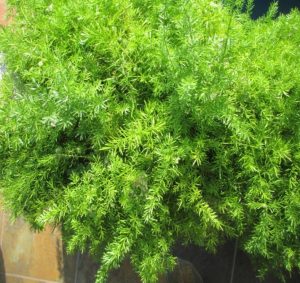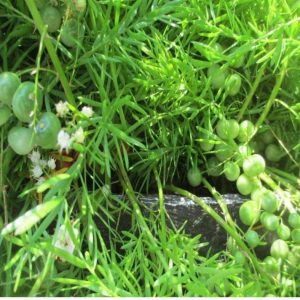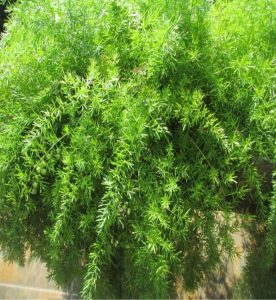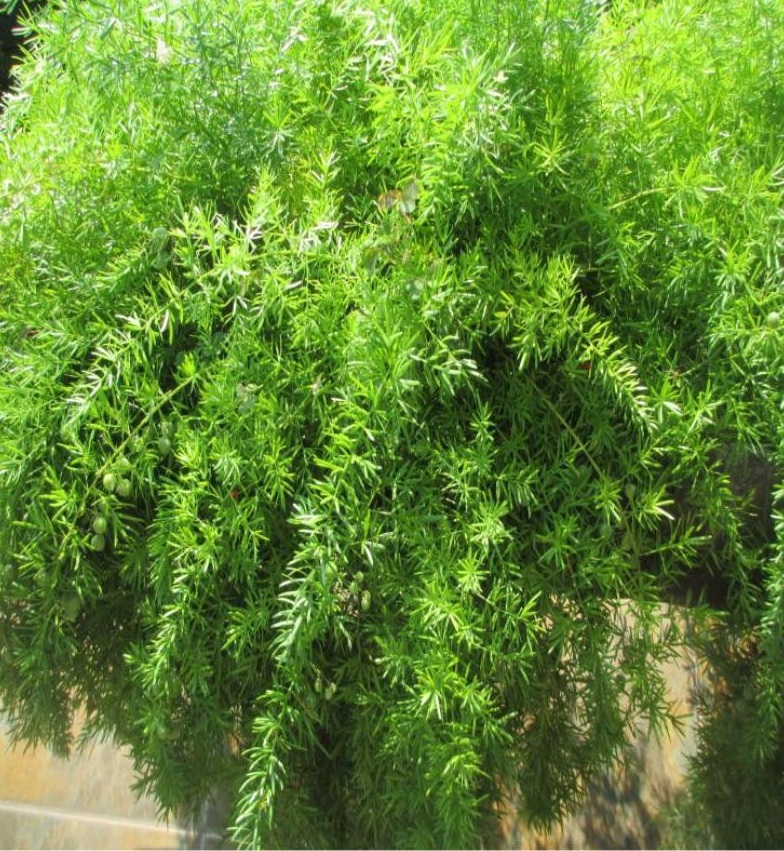By Tommy Clarkson from the December 2014 Edition

Asparagus Fern, Protasparagus densiflorus ‘Sprengeri’
Family: Strelitziaceae
(Known by no other names)
What we commonly call Asparagus Fern is, in fact, neither not an asparagus as we think of them (though in the same family) and not a fern! If the truth be known, they are actually members of the Lily family. They are native to the coastal areas in the southeastern part of the Cape of Good Hope in South Africa.
The Protasparagus densiflorus ‘Sprengeri’ is one of the most popular. These are for visually enjoying as – the name notwithstanding – don’t try to eat them because all parts have an unpleasant toxicity.
Regardless of that fact, several different varieties of Asparagus Fern have been grown as house plants since the late 19th century. They are favorites for such in that they grow fast and need little attention or maintenance. The ‘Sprengeri’ has its dense fern-like foliage which forms an arching mound that matures to one to three feet (30 ½ – 91 ½ cm) tall spreading to three to four feet (91 ½ – 122 cm) wide and which can be trained to cascade down from a hanging planter, or to grow somewhat like a vine.
Upon first perusal of them one might wonder about those needle-like leaves. Actually, they are cladodes which perform the necessary process of the plants photosynthesis. Its actual leaves are quite tiny, scale-like and appear where the cladode meets the stem.


Sprenger’s Asparagus is a branching perennial with wiry green stems that are sparsely covered with clusters of three to four, ¾” (1.9 cm) in size, cladodes along the stem. They produce small white or pinkish-white flowers in the spring, followed by green berries that will turn red by mid-winter and which birds love!
Now if you are near a Sprenger’s Fern please don’t read the following out loud for fear of hurting its tender feelings. This particular variety has actually been declared a noxious weed in the States of Florida, Hawaii and in New Zealand.
But in locales like ours where we enjoy and appreciate them, they, like the more conventional ferns, requires the same basic care whether grown indoors or out. They prefer bright, indirect sun. Direct, hot sunlight will scorch its needles. Conversely, insufficient sunlight will cause theme to yellow and drop off. And, if given the choice, they would prefer temperatures between 70 -75 degrees Fahrenheit (21 -24 Celsius) during the day and ten degrees cooler at night.
Rich, well-draining (perhaps slightly acidic) soil is its preferred growing medium. It can tolerate short periods of drought but thrives when given plenty of water and occasionally misted. While in its growing mode they also like a liquid all-purpose fertilizer. And remember that easy to maintain fact? To maintain the desired plant form merely pinch back stem tips as needed to promote dense foliage growth.
Be aware that, as a result of their developing large tuberous roots, Asparagus Fern can become pot bound rather quickly. While they will generally grow and flower more in this condition, it is imperative that they be given a regular drenching of water. Beyond that, plan on repotting every three to four years.
If pruning is necessary, cut the entire stems back all the way to the base of the plant rather than merely shortening them.
While they have no major insect or disease problems, Asparagus Ferns are slightly susceptible to spider mites, scale insects and mealybugs. If an infestation has gotten out of control, simply cut off the stems all the way back to the soil line and carefully discard the infested foliage. New stems will then rapidly grow back from the bulbs.
They can develop yellow needles for many different reasons, including a change in light, rapid temperature change, over watering, under watering, and spider mites.
The easiest and fastest way to propagate new Asparagus Ferns is by division. Just slice the root ball into half or quarter sections with a sharp knife or pull the tubers apart by hand. Asparagus Sprengeri produces small bulblets which also can be planted.
These plants are dioecious (meaning that both male and female plants must be present to produce). If your plant has berries, you can harvest a single seed from each one. Remove the pulp and soak them in room temperature water overnight. Then plant them ½” ( 1 ¼ cm) deep in a tray or pots. Strive to maintain a temperature in the planting medium at 70°-80° until the seeds germinate. This takes about four weeks.
For back issues of “Roots”, gardening tips, tropical plant book reviews and videos of numerous, highly unique eco/ adventure/ nature tours, as well as memorable “Ultimate Experiences” such a Tropical Garden Brunches and Spa Services, visit us at.. www.olabrisagardens.com
Download the full edition or view it online
—
Tommy Clarkson is a bit of a renaissance man. He’s lived and worked in locales as disparate as the 1.2 square mile island of Kwajalein to war-torn Iraq, from aboard he and Patty’s boat berthed out of Sea Bright, NJ to Thailand, Germany, Hawaii and Viet Nam; He’s taught classes and courses on creative writing and mass communications from the elementary grades to graduate level; He’s spoken to a wide array of meetings, conferences and assemblages on topics as varied as Buddhism, strategic marketing and tropical plants; In the latter category he and Patty’s recently book, “The Civilized Jungle” – written for the lay gardener – has been heralded as “the best tropical plant book in the last ten years”; And, according to Trip Advisor, their spectacular tropical creation – Ola Brisa Gardens – is the “Number One Tour destination in Manzanillo”.





You must be logged in to post a comment.